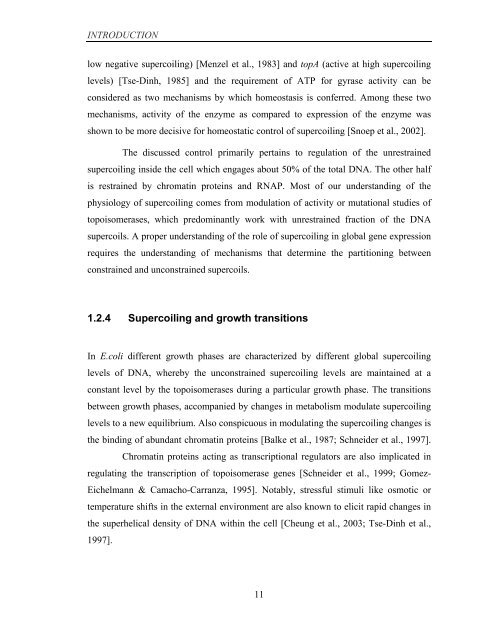Coordinated regulation of gene expression by E ... - Jacobs University
Coordinated regulation of gene expression by E ... - Jacobs University
Coordinated regulation of gene expression by E ... - Jacobs University
You also want an ePaper? Increase the reach of your titles
YUMPU automatically turns print PDFs into web optimized ePapers that Google loves.
INTRODUCTION<br />
low negative supercoiling) [Menzel et al., 1983] and topA (active at high supercoiling<br />
levels) [Tse-Dinh, 1985] and the requirement <strong>of</strong> ATP for gyrase activity can be<br />
considered as two mechanisms <strong>by</strong> which homeostasis is conferred. Among these two<br />
mechanisms, activity <strong>of</strong> the enzyme as compared to <strong>expression</strong> <strong>of</strong> the enzyme was<br />
shown to be more decisive for homeostatic control <strong>of</strong> supercoiling [Snoep et al., 2002].<br />
The discussed control primarily pertains to <strong>regulation</strong> <strong>of</strong> the unrestrained<br />
supercoiling inside the cell which engages about 50% <strong>of</strong> the total DNA. The other half<br />
is restrained <strong>by</strong> chromatin proteins and RNAP. Most <strong>of</strong> our understanding <strong>of</strong> the<br />
physiology <strong>of</strong> supercoiling comes from modulation <strong>of</strong> activity or mutational studies <strong>of</strong><br />
topoisomerases, which predominantly work with unrestrained fraction <strong>of</strong> the DNA<br />
supercoils. A proper understanding <strong>of</strong> the role <strong>of</strong> supercoiling in global <strong>gene</strong> <strong>expression</strong><br />
requires the understanding <strong>of</strong> mechanisms that determine the partitioning between<br />
constrained and unconstrained supercoils.<br />
1.2.4 Supercoiling and growth transitions<br />
In E.coli different growth phases are characterized <strong>by</strong> different global supercoiling<br />
levels <strong>of</strong> DNA, where<strong>by</strong> the unconstrained supercoiling levels are maintained at a<br />
constant level <strong>by</strong> the topoisomerases during a particular growth phase. The transitions<br />
between growth phases, accompanied <strong>by</strong> changes in metabolism modulate supercoiling<br />
levels to a new equilibrium. Also conspicuous in modulating the supercoiling changes is<br />
the binding <strong>of</strong> abundant chromatin proteins [Balke et al., 1987; Schneider et al., 1997].<br />
Chromatin proteins acting as transcriptional regulators are also implicated in<br />
regulating the transcription <strong>of</strong> topoisomerase <strong>gene</strong>s [Schneider et al., 1999; Gomez-<br />
Eichelmann & Camacho-Carranza, 1995]. Notably, stressful stimuli like osmotic or<br />
temperature shifts in the external environment are also known to elicit rapid changes in<br />
the superhelical density <strong>of</strong> DNA within the cell [Cheung et al., 2003; Tse-Dinh et al.,<br />
1997].<br />
11
















